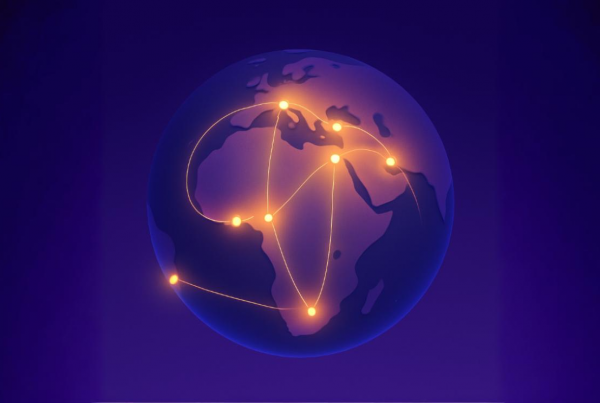Introduction
Conversations around cross-border payments in Africa often happen in silos, framed by how individual countries engage with markets outside the continent rather than with each other.
In Nigeria, for example, the focus is typically on remittances, money sent home from the diaspora in the United States, United Kingdom, and Canada, etc. In North Africa, the discussion often centres on Euro transactions and ties to European and middle east markets.
This fragmented narrative reflects a broader reality: Africa trades more with other continents than it does with itself. In fact, intra-African trade accounts for just 15% of the continent’s total trade volume, compared to around 60% in Asia and 70% in Europe. This gap raises a critical question: Why is there so little trade between African countries?
The answers are many and deeply structural.
Africa, by design and historical legacy, is fragmented across the very systems that enable trade: infrastructure, finance, regulation, and production. Transport is a major barrier; it’s often faster and cheaper to ship goods from Lagos to London than from Lagos to Nairobi. According to the African Development Bank, poor infrastructure can increase the cost of intra-African trade by 30 to 40%.
On the financial side, cross-border payments within Africa remain expensive and slow. This is largely due to the absence of connected payment rails across markets.
Most transactions are still settled in foreign currencies, especially the U.S. dollar, requiring external correspondent banking. Unlike the Eurozone, Africa has no unified currency or even a dominant one for regional trade, which compounds both costs and delays.
The regulatory environment adds another layer of friction. With over 50 different legal systems, customs procedures, and licensing requirements, there is no unified framework to simplify cross-border transactions. Even digital platforms must navigate several local compliance rules.
Compounding the challenge is the lack of diversified economies. Many African countries export the same raw materials such as oil, minerals, or agricultural products which means there’s often little incentive for them to trade with one another. There’s limited complementarity in supply and demand across the continent.
And then there’s history. Africa’s trade infrastructure was built to serve colonial interests, moving raw materials out and importing finished goods in. Those patterns still dominate today, making it far easier to trade with Europe, North America, or Asia than across African borders.
Even central banks are part of the problem. Most focus more on currency stability than on enabling regional trade. Without liquidity infrastructure or systems like PAPSS (the Pan-African Payment and Settlement System), cross-border payments are still routed through foreign banks, again, in dollars or euros.
To unlock Africa’s full trade potential, we need to build connected systems on purpose. That means strengthening not just roads and ports, but the payment rails that move money across the continent. Because without seamless, affordable cross-border payments, trade cannot scale.
The current state of cross border payment within Africa
Despite growing demand for trade and digital commerce within Africa, sending money across African borders remains costly, fragmented, and often unreliable. In the absence of fully integrated financial systems, Africans rely on formal and informal methods to move money across countries.
Informal systems
According to Afreximbank’s 2024 Informal Cross-Border Trade (ICBT) in the Economic Community of West African States (ECOWAS) region, informal trades are valued at about %5.7m per month on an average. These informal trades are driven by informal payment methods which remain the most accessible option for many in Africa.
These include physical cash couriers, family members, bus drivers, or cross-border traders who carry money across borders on behalf of others.
In some regions, informal agents operate underground networks where Naira is exchanged for CFA francs, or South African rand for Mozambican metical, often based on trust and community ties.
Barter still exists in some cross-border trading hubs, particularly among small-scale traders operating along porous borders where formal systems are absent or unaffordable. While these methods offer flexibility and speed, they come with significant risks, including fraud, theft, lack of documentation, and no legal recourse.
Bank transfers
Traditional bank-to-bank transfers are often used for large transactions or formal business dealings.
However, they come with high fees, long processing times, and limited interoperability between national banking systems. A transfer from Nigeria to Ghana, for example, might be routed through correspondent banks in Europe or the U.S., requiring conversion to USD before being re-converted to local currency.
This not only delays the payment but also adds multiple layers of exchange rate loss and transaction fees.
For many small businesses and individual traders, these costs make bank transfers an impractical option.
Mobile money
In East Africa, mobile money has revolutionised the way people send and receive funds across borders. Services like M-Pesa (Kenya, Tanzania, Uganda), MTN MoMo, and Airtel Money enable users to send money via their phones quickly and at relatively low cost. Regional corridors like Kenya-Uganda or Rwanda-Tanzania have benefited from growing interoperability between telecom operators and regulators.
However, mobile money’s success is uneven across the continent. In West and Central Africa, adoption has been slower, and interoperability remains limited.
For instance, a user in Nigeria cannot easily send money to a user in Benin or Togo using the same mobile platform, as most mobile wallets are restricted to domestic use or require third-party intermediaries.
Remittance services
Platforms like Western Union, MoneyGram, and WorldRemit remain widely used for sending money across African borders especially by the diaspora or for family support.
These services are trusted, fast, and available in both urban and rural areas. However, they are expensive, particularly for low-value transfers, and often require recipients to visit physical agents or bank branches to collect funds.
While some remittance providers are expanding their digital offerings, their cross-border reach within Africa is still limited compared to their international corridors.
Key challenges in cross-border payments across Africa
Despite increasing demand for seamless financial exchange within the continent, cross-border payments in Africa remain among the most complex and expensive in the world.
Currency fragmentation
Africa is home to over 40 national currencies, with no unified or dominant currency to facilitate regional trade. Unlike the Eurozone or parts of Asia, there is no shared legal tender or common exchange framework across African markets.
As a result, many cross-border payments must be routed through third-party currencies like the U.S. dollar or euro, adding unnecessary conversion layers, volatility risks, and transaction fees.
This dependency on external currencies slows down payments and reinforces Africa’s reliance on global financial infrastructure that wasn’t built with the continent in mind.
Regulatory differences
Each African country has its own financial regulations, licensing requirements, KYC (Know Your Customer), and AML (Anti-Money Laundering) rules.
This legal fragmentation creates friction for fintechs, banks, and businesses trying to operate across multiple jurisdictions.
There is currently no continent-wide framework that allows payment providers to scale easily or to interoperate without going through complex country-by-country compliance processes. This lack of harmonisation discourages innovation and slows the adoption of regional financial solutions.
High costs
The average cost of sending money across African borders is over 8%, according to the World Bank—nearly three times the global average. These fees hit small traders, e-commerce entrepreneurs, and low-income families the hardest, especially those making frequent or low-value transactions.
High transaction costs are driven by a mix of poor infrastructure, lack of competition, currency conversions, and reliance on foreign correspondent banks.
Infrastructure limitations
Most African countries lack real-time gross settlement systems that can handle cross-border transactions efficiently. Payments between countries are often delayed by outdated technology, manual reconciliation processes, and intermediaries with no shared communication protocols.
Without infrastructure that supports instant or near-instant settlement, businesses face delays, uncertainty, and cash flow disruptions, making trade slower and riskier.
Limited interoperability
National payment systems, including mobile money platforms, are largely designed for domestic use, and most are not connected to one another.
For example, a mobile wallet in Kenya (like M-Pesa) cannot easily send money to a wallet in Nigeria or Ghana, even though both countries have high mobile money usage.
This lack of interoperability is one of the most critical barriers to unlocking intra-African commerce, especially for SMEs and digital entrepreneurs who rely on fast, affordable transactions to stay competitive.
The uneven landscape of cross-border payments in Africa
Africa’s approach to cross-border payments is anything but uniform. Each region presents a different story shaped by infrastructure, regulation, and financial behavior. Understanding these regional case studies reveals both the promise and pitfalls of integrating payments across the continent.
East Africa: Leading with mobile money
East Africa is often cited as the blueprint for mobile money success, thanks largely to Kenya’s M-Pesa, launched in 2007. Today, countries like Kenya, Uganda, Tanzania, and Rwanda boast high mobile money penetration, with millions using wallets for everyday transactions from paying bills to sending cross-border remittances.
Regional mobile money interoperability has also seen some progress:
Rwanda, Kenya, and Uganda have introduced bilateral integrations enabling users to send money across borders directly from mobile wallets.
Telcos like Safaricom and MTN have expanded partnerships across East Africa to support real-time wallet-to-wallet transfers.
However, while East Africa leads the continent in mobile financial inclusion, scaling this model to broader Africa remains challenging due to differences in regulation, market structure, and infrastructure.
West Africa: momentum meets fragmentation
In West Africa, mobile money is gaining traction, but the ecosystem is still fragmented. Countries like Ghana and Côte d’Ivoire have strong adoption, with operators like MTN MoMo, Orange Money, and Wave enabling digital payments and transfers.
In Nigeria, however, mobile money uptake has been slower due to a bank-dominated payment ecosystem and regulatory caution.
For example; sending money from Ghana to Nigeria still requires intermediaries or third-party apps. Local currency settlements are difficult due to reliance on USD rails.
Nonetheless, the region has a vibrant fintech scene, and with better infrastructure and regulatory cooperation, West Africa could become a cross-border payments powerhouse.
Southern Africa: solid banks, slow Innovation
Southern Africa has a relatively well-established banking infrastructure, particularly in countries like South Africa, Namibia, and Botswana.
Traditional banks dominate formal payments, and digital innovation has lagged behind the East and parts of West Africa.
Cross-border payments tend to rely on bBank wires and SWIFT transfers and SIRESS (SADC Integrated Regional Electronic Settlement System), which allows real-time settlement in South African rand across SADC member countries
While effective for large transactions, these systems often exclude SMEs and informal traders due to high costs and documentation requirements.
Fintech disruption is still emerging in this region, and regulatory conservatism has slowed the entry of mobile-first, API-driven platforms.
Francophone vs. anglophone divide
Africa’s colonial legacy has also left behind a stark divide in how financial systems operate. Francophone Africa, mainly in West and Central Africa uses the CFA franc, a currency pegged to the euro and governed by the French Treasury. This gives the region a shared currency but limits monetary policy flexibility and creates dependence on external FX systems.
In contrast, Anglophone countries like Nigeria, Kenya, and Ghana operate independent currencies and central banks, leading to greater innovation potential but also more fragmentation and FX risk.
The divide is also regulatory. Francophone countries often follow OHADA law and centralised banking models via BEAC and BCEAO.
Anglophone countries have independent regulatory environments, which can be both an opportunity and a challenge for fintechs.
Bridging this gap is crucial to building truly pan-African payment infrastructure that serves all linguistic and legal systems.
Emerging solutions
While cross-border payments in Africa remain costly and fragmented, there is growing momentum across the continent to build systems that work better for Africans.
A mix of central bank initiatives, fintech innovation, and blockchain technology is beginning to lay the groundwork for a more integrated and inclusive payment landscape.
Pan-African Payment and Settlement System (PAPSS)
Launched by the African Export-Import Bank (Afreximbank) in collaboration with the African Union and central banks, PAPSS is one of the most ambitious efforts to date to transform intra-African payments.
PAPSS enables instant, real-time payments across African countries, allowing businesses and individuals to settle transactions in local currencies without first converting to USD or EUR. It effectively reduces the need for foreign correspondent banks, lowers transaction costs, and speeds up trade settlement.
By integrating central banks and licensed commercial banks across participating countries, PAPSS is building the financial rails for the African Continental Free Trade Area (AfCFTA) to function efficiently.
Fincra
Fincra is addressing the fragmented, expensive, and inefficient cross-border payment landscape in Africa by building the financial infrastructure or rails required for an integrated African economy.
These rails are designed to power seamless cross-border payments, enable intra-African trade, and support scalable economic growth.
Building the rails for an integrated Africa
Fincra is building the rails that allows money to move seamlessly between African countries, even in the absence of a shared currency. Fincra sees payment rails as the veins of economic freedom in Africa.
Tackling currency fragmentation through FX innovation
Africa’s cross-border payments rely heavily on USD or EUR due to the lack of currency interoperability. Fincra is solving this by:
- Building API-based FX infrastructure that automates currency exchange.
- Enabling conversion across local African currencies without relying on external banks.
- Laying the foundation for an all-in-one API that converts any African currency to another or to global currencies.
This reduces cost, speeds up payments, and removes dependency on foreign currency pairs.
Supporting mobile money and wallet integration
Fincra is leveraging the ubiquity of mobile money in Africa by working to connect wallets across countries. This includes:
- Supporting platforms like MPESA and MTN MoMo for collections and disbursements.
- Exploring interoperability across providers and borders.
This unlocks low-value, high-frequency trade among individuals and SMEs.
API-Driven treasury and automation
Today, many cross-border fintechs still rely on manual treasury operations, often using informal platforms like WhatsApp. Fincra is changing this by:
- Providing automated treasury management through APIs.
- Reducing the need for each fintech to build its own FX operations from scratch.
This encourages competition, lowers market entry barriers, and increases efficiency.
Multi-channel payment solutions
Fincra’s Pay-In and Pay-Out systems support:
- Bank transfers
- Mobile money
- Virtual accounts
- Payment links and embedded checkouts
These work across multiple currencies including NGN, KES, EUR, and USD, giving businesses and platforms the flexibility to operate across borders with minimal friction.
Advocacy through the Afincran movement
Fincra is also building a broader ecosystem through the Afincran movement, a coalition of builders, regulators, and innovators committed to solving Africa’s economic challenges through connected systems.
The goal is to align with the AfCFTA’s vision by providing the rails that make regional trade truly seamless.
Conclusion
When we talk about ‘payment rails’, we’re referring to the underlying infrastructure that enables money to move from one place to another across countries, currencies, and systems. Just like physical train rails connect distant cities, payment rails connect financial institutions, banks, wallets, and systems, allowing money to flow reliably and at speed.
In Europe, these rails already exist and that’s what makes cross-border payments fast, cheap, and seamless.
There are existing APIs to plug into that support EUR, GBP, and USD conversions. Fincra is building the APIs for such conversions in African currencies.
Just like Europe built decades of alignment into its economy, Fincra is laying the financial groundwork for a connected Africa, where cross-border payments no longer require a leap across oceans, currencies, or disconnected systems.




